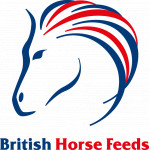Posted: 26th November 2018 | Back to news feed

In this issue British Horse Feeds sponsored showjumper Pippa Allen explains what a double is and how it should be jumped.
A double is two fences jumped closely together usually with one or two strides in between.
As a rider, you should know how to stride out a distance between doubles and it’s important that you are consistent with your own stride length when pacing out the distances to measure the number of strides your horse will take.
This takes practice and experience. Try measuring out the true distance of a one stride double applicable to your horse and practice striding the distance until you know what length of stride you should take.
As a rough guide, for a horse a one stride double will be eight of your strides. A two stride double will be twelve strides.
It is also important to know your horse and how they move. Horses’ strides can vary in length and it’s handy to know if the striding for them is going to be long or short so you know how to approach and ride the combination of fences.
You may also need to adjust your horse's stride according to the type of obstacle that must be jumped, and the order they occur. Horses take off and land at different distances from the obstacle depending on its type: usually closer for triple bars, slightly further for oxers, and even further for verticals. For example, a vertical to an oxer will ride differently than an oxer to a vertical. Other factors such as a "spooky" fence may make the horse back off and will result in a change in the stride and the distances between the fences.
Here Pippa advises the best way to tackle a double...
As you approach a double, you want your horse to be well balanced, on his hocks and in a rhythmical, bouncy canter. Before you approach the fence use the corner well, looking for your fence, so that you can set your horse up and keep the approach straight whilst keeping them between the hand and leg.
It is important for the rider to stay balanced, keeping a contact throughout. When one or more fences are linked together, they require athleticism and power from the horse. He must be presented correctly at the first element so that he is able to jump the following fence.
It is all about setting your horse up to jump well over the first part of the double because this determines how he will jump the second element. The more impulsion the horse has on the approach, the more chance he has of meeting the first part on a good stride.
This means that you must not over-ride so that you interfere with the rhythm or balance. It’s all about being accurate and in control in order to keep straight and your horse moving forward through the double.
Pippa’s horses enjoy Fibre-Beet as part of a balanced diet. Fibre-Beet is a versatile, super-fibre conditioning feed and when fed alongside a balanced diet can improve energy intake in performance horses whilst keeping fibre levels at an optimum.
Offering an excellent source of highly digestible fibre in a soaked form, Fibre-Beet is excellent in aiding rapid rehydration and provides slow release energy without the ‘fizz’.
Fibre-Beet contains all the benefits of Speedi-Beet with added high quality alfalfa for optimum condition and to provide quality protein for muscle tone and function. Alfalfa can also help promote topline or simply help maintain weight and a healthy, shiny coat.
It is the first soaking mash product to be approved by BETA, making it suitable for horses and ponies prone to equine gastric ulcer syndrome (EGUS).
For more information on Fibre-Beet please contact British Horse Feeds on 01765 680300 or visit www.britishhorsefeeds.com.
The Equestrian Index newsfeed is compiled from articles submitted by advertising members and expresses the opinions of those members. Watsons Directories Ltd shall not be held liable for any inaccuracies or mis-statements therein.
